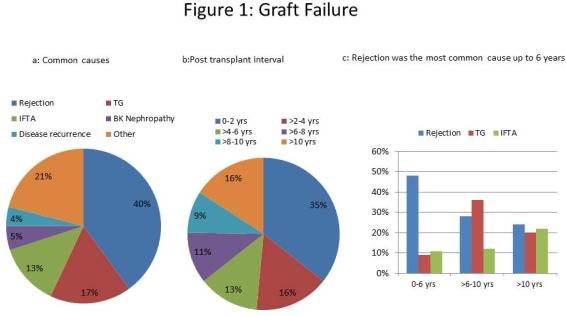Timeline and Histopathological Characteristics of Graft Failure after Kidney Transplantation: What is Preventable and What is Not?
University of Wisconsin, Madison.
Meeting: 2018 American Transplant Congress
Abstract number: D78
Keywords: Kidney transplantation
Session Information
Session Name: Poster Session D: Kidney Complications: Late Graft Failure
Session Type: Poster Session
Date: Tuesday, June 5, 2018
Session Time: 6:00pm-7:00pm
 Presentation Time: 6:00pm-7:00pm
Presentation Time: 6:00pm-7:00pm
Location: Hall 4EF
Background: There is limited information on the histopathological characteristics of kidney transplant recipients (KTRs) with graft failure at different post-transplant time intervals. Methods:We addressed this question in a single center observational study of KTRs with death censored graft failure between 01/01/2006 and 12/31/2016, who had a kidney biopsy within one year prior to the graft failure. Results: We identified 329 consecutive kidney graft failures satisfying the selection criteria. Mean age at the time of transplant was 42.2 ± 13.7 years and mean time from transplant to graft failure was 4.9 ± 4.4 years. The majority were male (n=202, 61%), and received deceased donor transplants (n=221, 67%). The five most common causes of graft failure (Fig. 1A) were rejection (n=132, 40%), transplant glomerulopathy (TG, n=56, 17%), IFTA (n=43, 13%), BK nephropathy (n=16, 5%), and disease recurrence (n=13, 4%). The most common time for graft failure was within the first two years of transplant (n=117, 36%) (Fig. 1B). Subsequently, approximately 10-15% of grafts were failed every two years: >2-4 years (n=51, 16%), >4-6 years (n=44,13%), >6-8 years (n=35,11%), >8-10 years (n=31,9%) and >10 years (n=51,16%). Rejection was the most common cause of graft loss in the first six years (n= 101 of 212, 48%) whereas TG was the most prevalent cause between years 6-10 (n=26 of 66, 39%). Graft loss after the 10th year was evenly distributed between rejection, TG, and IFTA (24%, 20%, 22%) (Fig. 1C). In patients with rejection, cellular rejection was more prevalent in the first two years (n=17 of 54, 31%) while antibody mediated rejection was most common throughout the intervals.  Conclusion: To the best of our knowledge, this is the largest case series of patients with a biopsy within a year of graft failure, to allow accurate assessment of the cause of failure. Our observations suggest that most graft failures occur within two years of transplant, are related to rejection, and are in theory preventable. The more challenging pathologies for treatment are TG and IFTA, which commonly occur after the 6th year.
Conclusion: To the best of our knowledge, this is the largest case series of patients with a biopsy within a year of graft failure, to allow accurate assessment of the cause of failure. Our observations suggest that most graft failures occur within two years of transplant, are related to rejection, and are in theory preventable. The more challenging pathologies for treatment are TG and IFTA, which commonly occur after the 6th year.
CITATION INFORMATION: Parajuli S., Aziz F., Garg N., Muth B., Mohamed M., Zhong W., Astor B., Mandelbrot D., Djamali A. Timeline and Histopathological Characteristics of Graft Failure after Kidney Transplantation: What is Preventable and What is Not? Am J Transplant. 2017;17 (suppl 3).
To cite this abstract in AMA style:
Parajuli S, Aziz F, Garg N, Muth B, Mohamed M, Zhong W, Astor B, Mandelbrot D, Djamali A. Timeline and Histopathological Characteristics of Graft Failure after Kidney Transplantation: What is Preventable and What is Not? [abstract]. https://atcmeetingabstracts.com/abstract/timeline-and-histopathological-characteristics-of-graft-failure-after-kidney-transplantation-what-is-preventable-and-what-is-not/. Accessed December 22, 2025.« Back to 2018 American Transplant Congress
